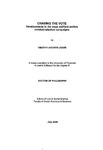Chasing the vote : developments in the ways political parties conduct election campaigns
| dc.contributor.supervisor | Rallings, Colin | |
| dc.contributor.author | Jones, Timothy Andrew | |
| dc.contributor.other | Faculty of Arts, Humanities and Business | en_US |
| dc.date.accessioned | 2011-05-11T10:34:01Z | |
| dc.date.available | 2011-05-11T10:34:01Z | |
| dc.date.issued | 2008 | |
| dc.identifier | Not available | en_US |
| dc.identifier.uri | http://hdl.handle.net/10026.1/373 | |
| dc.description.abstract |
The methods political parties use to engage the electorate during election campaigns undergo a continual process of re-evaluation and modification; this study seeks to further understanding of this process by proposing the concept of a toolkit of techniques from which those who plan campaigns make selections, based on the type of campaign and the resources they have available. Using data gathered from interviews of experienced campaigners, a case study from the 2007 local elections, and the author's own experience as a political campaigner, the development of campaigning is considered from the perspective of the candidate and campaigner 'on the ground'. Three main drivers of change are considered: increasing levels of partisan dealignment and a decline in party membership, the opportunities that technological innovations have afforded, and regulatory change. The development of new communication channels and the ease of accessibility to sophisticated technology are changing the basic processes of electioneering. Several of the new techniques now gaining favour place less emphasis on the need for face-to-face communication, allowing 'campaigning at a distance'. New data manipulation techniques allow campaigners to target voters in more precise ways, using personalised literature, email and the internet. Greater dependence on technology has led to the role of central party organisations becoming more dominant; many of the new approaches are also more costly than traditional methods, raising concerns about the abilities of minor parties and independent candidates to campaign on equal terms. The introduction of on-demand postal voting has introduced a second peak of activity during a campaign, moving the focus of an election away from a single polling day and creating a period of uncertainty in the final days of a campaign. | en_US |
| dc.description.sponsorship | Local Government Chronicle Elections Centre at the University of Plymouth. | en_US |
| dc.language.iso | en | en_US |
| dc.publisher | University of Plymouth | en_US |
| dc.title | Chasing the vote : developments in the ways political parties conduct election campaigns | en_US |
| dc.type | Thesis | |
| dc.identifier.doi | http://dx.doi.org/10.24382/1441 |
Files in this item
This item appears in the following Collection(s)
-
01 Research Theses Main Collection
Research Theses Main


